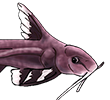good to hear news on this topic. I always doubted the theory of the common bristlenose being a hybrid but also was quite sure that it's not A. cirrhosus but didn't have a clue what else it could be...
Yes, the only L 144 (a male) was imported from Paraguay but the rest is not correct.pleco_breeder wrote:Again, as is stated several times on forums around the world, the only imported specimen of the true L144 was from Paraguay. Although it isn't documented that I'm aware of, the common belief is this fish was crossed back to the common strain to produce the blue eye gold strain now commonly sold as L144 and bred frequently with other strains of common.
It was crossed back by Kerstin Holota with normally coloured specimen of the same shipment and already some of the first offspring were yellow. So apparently this female was the same species as the L 144 (as least to my knowledge xanthorism is recessive in bristlenoses). Sometimes you can read that the female was L 110/L 157 which is evidently wrong as those don't come from Paraguay. A much more plausible assumption is that L 144 is the same species as Ancistrus sp. "Rio Paraguay" as the normally coloured Ancistrus of this shipment were descibed as dark brown with reddish brown spots.
The "true" L 144 are not what is commonly sold as "L 144" (at least here in Germany) but the xanthoristic form of the common bristlenose. The latter ones have a much nicer yellow colour whereas the true L 144 are more "dirty" and paler, sometimes even kind of brownish. For that reason the true L 144 has disappeared or at least become very rare in the hobby. Some time back Ingo Seidel said in Switzerland there were still quite a few of them there and propably still are.
It is not suprising that your "L 144" has an identical haplotype as the common bristlenose as it's no L 144 but IMHO the xanthoriostic form of the common bristlenose.
I would also be very interesting to get also some L 144 and compare them to A. sp. "Rio Paraguay".
Cheers,




